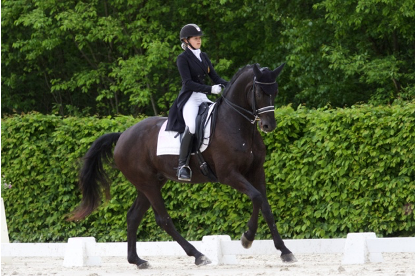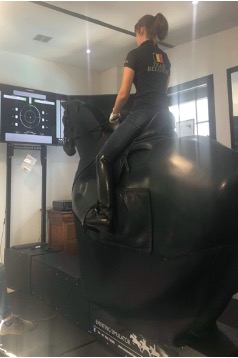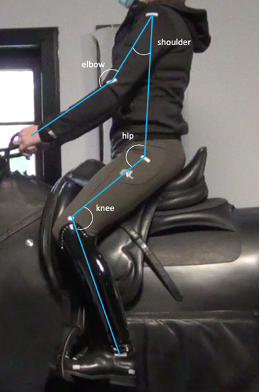De biomechanische vingerafdruk van de dressuurruiter
- SamVan Rossom
- PhilippeMinguet
Ik ben zelf dressuurruiter en het valt me steeds op hoe regelmatig de vraag rijst: “Is paardrijden wel echt een sport?”.
Mijn masterproef gaat dieper in op de biomechanica en de fysieke capaciteiten van de dressuurruiter.
Achtergrond
![]()

Dressuur, een olympische discipline binnen de paardensport, valt eigenlijk sterk te vergelijken met paarrijden in het kunstschaatsen. De partners moeten perfect afgestemd zijn op elkaar om de oefeningen technisch goed te kunnen uitvoeren.
De ruiter dient een “dynamisch stabiele zit” te hebben, dit wilt zeggen dat de ruiter de bewegingen van het paard passief kan volgen en in balans blijft zonder afhankelijk te zijn van zich vast te grijpen aan de teugels of overmatig te knijpen met de benen. Ondertussen moet de ruiter het paard begeleiden d.m.v. fysieke signalen via de benen en handen die de teugels hanteren, ook wel “hulpen” genoemd.
De ideale dressuurhouding van de ruiter op het paard is goed beschreven, maar objectieve meetdata zijn nog schaars en de trainingen zijn eerder ervarings -en expertsgericht. Welke fysieke capaciteiten de ruiter nodig heeft om de meest formante houding te kunnen bekomen en dus succesvol te zijn, is grotendeels onbekend.
Het doel van mijn masterproef was daarom enerzijds om de houding van de dressuurruiter op het paard te objectiveren en anderzijds om de fysieke capaciteiten van de dressuurruiter te evalueren.
Methode

Om dit te doen namen we twee groepen dressuurruiters: een groep onervaren dressuurruiters die ten hoogste niveau initiatie op regionaal niveau gereden hebben, en een groep ervaren dressuurruiters die minimaal op nationaal niveau competitie reden. De metingen bestonden uit twee delen: een biomechanische simulatoranalyse en een kinesitherapeutische screening.
Bij de biomechanische simulatoranalyse namen de ruiters plaats op een soort robotpaard. Deze simulator bevat vier druksensoren onder het zadel en één krachtsensor in elke teugel en is geprogrammeerd om de bewegingen van het paard na te bootsen. De ruiters voerden hiermee de negen dressuurgangen uit en werden ondertussen ook gefilmd van de linkerzijde.
De kinesitherapeutische screening bestond uit zes fysieke testen die geselecteerd zijn o.b.v. voorgaande literatuur die betrekking hadden op o.a. flexibiliteit, spierkracht, spiercontrole, coördinatie en reactiesnelheid.
Resultaten

![]()
Uit de resultaten van de simulatoranalyse bleek dat de variabiliteit van de kracht van de teugels doorheen de middengalop zowel links als rechts kleiner was bij de ervaren ruiters dan bij de onervaren ruiters.
In de video-analyse vonden we dat de hoek van de schouder groter was bij de ervaren ruiters, dit betekent dat ze hun armen meer voor zich uit positioneerden. Tijdens middenstap was ook de hoek van de elleboog groter, ze reden dus met meer gesterkte armen. De range of motion (bewegingsbereik) van de hoek van de knie en de romp was kleiner in verschillende gangen bij de ervaren ruiters, alsook de variabiliteit van de hoek van de romp.
In de kinesitherapeutische screening scoorden de ervaren ruiters beter op de Star Excursion Balance Test en de Upper-Quarter Star Excursion Balance Test in verschillende richtingen. Deze testen evalueren voornamelijk balans, rompstabiliteit, spiercontrole, spierkracht en coördinatie.
Besluit
Uit deze bevindingen kunnen we besluiten dat een dynamisch stabiele hand ervaren ruiters onderscheidt van onervaren ruiters zoals blijkt uit het kunnen behouden van een constante kracht op de teugels en de grotere hoek van de schouder. De ervaren ruiters hadden ook globaal een stabielere houding op de simulator zoals aangegeven werd door de kleinere range of motion van de hoek van de knie en romp en de kleinere variabiliteit van de hoek van de romp.
Tenslotte bieden de resultaten van de kinesitherapeutische screening het perspectief om te onderzoeken of de Star Excursion Balance Test en de Upper-Quarter Star Excursion Balance Test betrouwbare testen zijn voor het trainen en opvolgen van dressuurruiters om zo uiteindelijk te leiden tot betere sportprestaties.
Bibliografie
1. Lee, J.T., et al., THE FEASIBILITY OF AN 8-WEEK, HOME-BASED ISOMETRIC STRENGTH TRAINING PROGRAM FOR IMPROVING DRESSAGE TEST PERFORMANCE IN EQUESTRIAN ATHLETES. 2015.
2. Clayton, H.M. and S.J. Hobbs, The role of biomechanical analysis of horse and rider in equitation science. Applied Animal Behaviour Science, 2017.
3. Eckardt, F. and K. Witte, Kinematic Analysis of the Rider According to Different Skill Levels in Sitting Trot and Canter. Journal of Equine Veterinary Science, 2016.
4. Schils, S.J., et al., Kinematic analysis of the equestrian - Walk, posting trot and sitting trot. Human Movement Science, 1993.
5. Nevison, C.M. and M.A. Timmis, The effect of physiotherapy intervention to the pelvic region of experienced riders on seated postural stability and the symmetry of pressure distribution to the saddle: A preliminary study. Journal of Veterinary Behavior: Clinical Applications and Research, 2013.
6. Gunst, S., et al., Influence of Functional Rider and Horse Asymmetries on Saddle Force Distribution During Stance and in Sitting Trot. J Equine Vet Sci, 2019. 78: p. 20-28.
7. Hobbs, S.J., et al., Posture, flexibility and grip strength in horse riders. J Hum Kinet, 2014. 42: p. 113-25.
8. MacKechnie-Guire, R., et al., The Effect That Induced Rider Asymmetry Has on Equine Locomotion and the Range of Motion of the Thoracolumbar Spine When Ridden in Rising Trot. J Equine Vet Sci, 2020. 88: p. 102946.
9. Symes, D. and R. Ellis, A preliminary study into rider asymmetry within equitation. Vet J, 2009. 181(1): p. 34-7.
10. Aegerter, A.M., et al., An investigation into association of the physical fitness of equestrians and their performance: A cross-sectional study. 2020.
11. Nevison, C., et al., The Effect of Physiotherapy on Rider Asymmetry Through the Seat and Upper Torso. Journal of Veterinary Behavior, 2013.
12. Ille, N., et al., Riding Simulator Training Induces a Lower Sympathetic Response in Riders Than Training With Horses. Journal of Equine Veterinary Science, 2015.
13. Nevison, Hughes, and Cole, Variability in lower leg aids used to achieve gait transitions on a dressage simulator. Journal of Veterinary Behavior, 2011. Vol 6.
14. Kang, O.D., et al., Comparative analyses of rider position according to skill levels during walk and trot in Jeju horse. Hum Mov Sci, 2010. 29(6): p. 956-63.
15. Viruega, H., et al., Short- and Mid-Term Improvement of Postural Balance after a Neurorehabilitation Program via Hippotherapy in Patients with Sensorimotor Impairment after Cerebral Palsy: A Preliminary Kinetic Approach. Brain Sci, 2019. 9(10).
16. Kim, S., G.C. Yuk, and H. Gak, Effects of the horse riding simulator and ball exercises on balance of the elderly. J Phys Ther Sci, 2013. 25(11): p. 1425-8.
17. Yoo, J.H., et al., The effect of horse simulator riding on visual analogue scale, body composition and trunk strength in the patients with chronic low back pain. Int J Clin Pract, 2014. 68(8): p. 941-9.
18. Baillet, H., et al., Human Energy Expenditure and Postural Coordination on the Mechanical Horse. J Mot Behav, 2017. 49(4): p. 441-457.
19. Douglas, J.L., M. Price, and D.M. Peters, A systematic review of physical fitness, physiological demands and biomechanical performance in equestrian athletes. Comparative Exercise Physiology, 2012.
20. Gaunt, A., et al., The effect of strength training on dynamic postural stability in junior elite horse riders. 2019.
21. Murphy, C.A., B.W. Glace, and M.P. McHugh, a Comparative Analysis of Strength and Flexibility in Equestrians and Non-Equestrians.Medicine & Science in Sports & Exercise, 2003.
22. Yurdalan, S.U., S. Kondu, and M. Malkoç, Assessment of health-related fitness in the patients with end-stage renal disease on hemodialysis: Using eurofit test battery. Renal Failure, 2007.
23. Keane, A., et al., Fitness test profiles as determined by the Eurofit Test Battery in elite female Gaelic Football players. Journal of Strength and Conditioning Research, 2010. Vol 24.
24. Peters, M.J.H., et al., Revised normative values for grip strength with the Jamar dynamometer. Journal of the Peripheral Nervous System, 2011.
25. Van Den Beld, W.A., et al., Validity and reproducibility of the jamar dynamometer in children aged 4-11 years. Disability and Rehabilitation, 2006. Vol 28.
26. Gribble, P.A., J. Hertel, and P. Plisky, Using the star excursion balance test to assess dynamic postural-control deficits and outcomes in lower extremity injury: A literature and systematic review. Journal of Athletic Training, 2012.
27. Plisky, P.J., et al., The reliability of an instrumented device for measuring components of the star excursion balance test. North American Journal of Sports Physical Therapy : NAJSPT, 2009.
28. Gorman, K., et al., UQYBT: Reliability and Performance Comparison Between Genders in Active Adults. Journal of Strength and Conditioning Research, 2012.
29. Westrick, R.B., et al., Exploration of the y-balance test for assessment of upper quarter closed kinetic chain performance. International Journal of Sports Physical Therapy, 2012.
30. FEI, DRESSAGE RULES 25th edition , effective 1st January 2014 Including updates effective 1 st January 2015, F.E. Internationale, Editor. 2015.
31. Mackechnie-Guire, R., et al., Relationship Between Saddle and Rider Kinematics, Horse Locomotion, and Thoracolumbar Pressures in Sound Horses. Journal of Equine Veterinary Science, 2018.
32. Egenvall, A., et al., Rein Tension in Transitions and Halts during Equestrian Dressage Training. Animals, 2019.
33. Buchner, H.H.F., et al., Body Centre of Mass Movement in the Sound Horse. Veterinary Journal, 2000.
34. Wilkins, C.A., et al., Static pelvic posture is not related to dynamic pelvic tilt or competition level in dressage riders. Journal of Sports Biomechanics, 2020.
35. Lee, W., et al., A new robotic horseback-riding simulator for riding lessons and equine-assisted therapy. International Journal of Advanced Robotic Systems, 2018.
36. Nemecek, P., L. Cabell, and M. Janura, Horse and Rider Interaction During Simulated Horse Jumping. Journal of Equine Veterinary Science, 2018.
37. Walker, A.M., et al., How realistic is a racehorse simulator? Journal of Biomechanics, 2016.
38. Keener, M.M., et al., The Effect of Stirrup Length on Impact Attenuation and Its Association With Muscle Strength. Journal of Strength and Conditioning Research, 2020.









